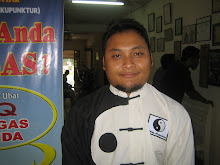Acupuncture-Like Treatments Improve Outcomes Compared to Usual Care for Low Back Pain
People suffering from chronic low back pain who received acupuncture or simulated acupuncture treatments fared better than those receiving only conventional care According to a recent study published in the Archives of Internal Medicine.[1] The study highlights central questions about the mechanisms of benefit seen in acupuncture studies.
This trial, led by Daniel Cherkin, Ph.D., of Group Health Center for Health Studies in Seattle, was funded by the National Center for Complementary and Alternative Medicine (NCCAM), a component of the National Institutes of Health.
"Because of the lack of highly effective medical treatments for chronic low back pain, we were pleased to find that acupuncture-like treatments were helpful for persons suffering from chronic back pain," said Dr. Cherkin. “However, the finding that real acupuncture produced no greater benefit than simulated acupuncture raises important questions about acupuncture’s mechanisms of action."
This trial enrolled 638 adults with chronic low back pain who had never had acupuncture and who had rated the "bothersomeness" of their pain as at least a 3 on a 0-to-10 scale. The participants were randomly assigned to one of four groups: individualized acupuncture, involving a customized prescription for acupuncture points from a diagnostician; standardized acupuncture, using a single prescription for acupuncture points that experts consider generally effective for chronic low back pain; simulated acupuncture, which mimics needle acupuncture but does not involve actual penetration of the skin; or usual care, which is standard medical care.
The patients assigned to any of the three acupuncture groups (individualized, standardized, or simulated) were treated twice weekly for three weeks, and then weekly for four weeks. At 8, 26, and 52 weeks, researchers measured back-related dysfunction and how much symptoms bothered participants.
The researchers found that at eight weeks the individualized, standardized, and simulated acupuncture groups all improved their dysfunction scores significantly more than the group receiving usual care. These benefits persisted for one year, though diminished over time. However, there was no significant difference between the groups receiving the needle and simulated forms of acupuncture. Thus, while acupuncture was found effective in treating low back pain, neither tailoring acupuncture needle sites to an individual patient nor penetrating the skin appears to be important for receiving therapeutic benefit.
"The findings of this research show that acupuncture-like treatments, including simulated acupuncture, can elicit positive responses," said Josephine P. Briggs, M.D., director of NCCAM. "This adds to the growing body of evidence that there is something meaningful taking place during acupuncture treatments outside of actual needling. Future research is needed to delve deeper into what is evoking these responses."
The researchers believe that further research is needed to determine the roles of patient expectancy, practitioner reassurance and the physiological effects of non-insertive stimulation and other effects that may contribute to acupuncture-like benefits.
The National Center for Complementary and Alternative Medicine’s mission is to explore complementary and alternative medical practices in the context of rigorous science, train CAM researchers, and disseminate authoritative information to the public and professionals. For additional information, call NCCAM’s Clearinghouse toll free at 1-888-644-6226, or visit the NCCAM Web site at nccam.nih.gov. NCCAM 1999–2009: Celebrating 10 years of rigorous research.
The National Institutes of Health (NIH) — The Nation's Medical Research Agency — includes 27 Institutes and Centers and is a component of the U.S. Department of Health and Human Services. It is the primary federal agency for conducting and supporting basic, clinical and translational medical research, and it investigates the causes, treatments, and cures for both common and rare diseases. For more information about NIH and its programs, visit www.nih.gov.
--------------------------------------------------------------------------------
Reference:
1 Cherkin DC, Sherman KJ, Avins AL, et al. A Randomized Trial Comparing Acupuncture, Simulated Acupuncture, and Usual Care for Chronic Low Back Pain. Archives of Internal Medicine. 2009;169[9]:858




















